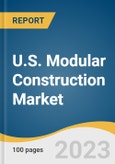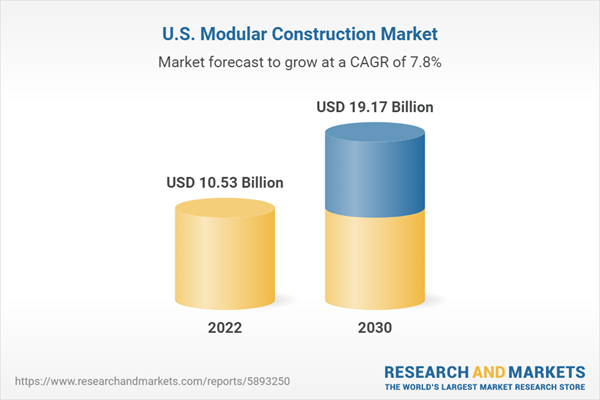The U.S. modular construction market size is expected to reach USD 19.17 billion by 2030, growing at a CAGR of 7.8% from 2023 to 2030. This is owing to the growing adoption of off-set building practices in the U.S. construction industry.
The U.S. construction industry is witnessing rapid changes with the introduction of new technologies and materials. Some of the advancements in the industry include modular or off-site construction, self-healing concrete, thermal bridging, photovoltaic glaze, kinetic footfall, kinetic roads, predictive software, 3D modeling, cloud collaboration, and asset mapping.
The growing construction industry is likely to face a shortage of skilled labor owing to the retiring baby boomers and millennials opting for other professions. In addition, a decreasing influx of foreign-born building workers is projected to negatively influence the availability of skilled workers. To address the issue of labor shortage, the industry is moving toward off-site production methods such as modular buildings, prefabrication, and pre-engineered buildings. These structures offer substantial advantages over traditional steel buildings.
The manufacturing process of modular buildings starts with the designing of the structures by considering the technical specifications. The architects and engineers design prefabricated structures using software such as StaadPro, AutoCAD, MBS, and Tekla. For designing modular structures, some manufacturers have in-house architects and engineers whereas some get designs from third-party vendors’ architects and engineers. The designs are sent to the customers for approval, after which the production is initiated. Module components are built in a controlled offsite environment while conducting grading and site excavation at the same time. After the completion of modules, they are transported to the final site.
Modular construction transforms the building industry, in terms of worker safety, quality, and sustainability. It incorporates a range of innovative advanced building materials, 3D printing technology, and new assembling techniques. The first part of offsite building comprises volumetric construction, which includes pod and modular construction. This technique permits the prefabrication of heavy 3D structures such as homes and rooms.
The second part involves panelized construction, under which the factory manufactures flat panels for use in floors, roof panes, and walls. Modern commercial buildings use this technique to install partitions and support elements. Therefore, various start-ups offer modular construction solutions to replace conventional building methods.
The U.S. construction industry is witnessing rapid changes with the introduction of new technologies and materials. Some of the advancements in the industry include modular or off-site construction, self-healing concrete, thermal bridging, photovoltaic glaze, kinetic footfall, kinetic roads, predictive software, 3D modeling, cloud collaboration, and asset mapping.
The growing construction industry is likely to face a shortage of skilled labor owing to the retiring baby boomers and millennials opting for other professions. In addition, a decreasing influx of foreign-born building workers is projected to negatively influence the availability of skilled workers. To address the issue of labor shortage, the industry is moving toward off-site production methods such as modular buildings, prefabrication, and pre-engineered buildings. These structures offer substantial advantages over traditional steel buildings.
The manufacturing process of modular buildings starts with the designing of the structures by considering the technical specifications. The architects and engineers design prefabricated structures using software such as StaadPro, AutoCAD, MBS, and Tekla. For designing modular structures, some manufacturers have in-house architects and engineers whereas some get designs from third-party vendors’ architects and engineers. The designs are sent to the customers for approval, after which the production is initiated. Module components are built in a controlled offsite environment while conducting grading and site excavation at the same time. After the completion of modules, they are transported to the final site.
Modular construction transforms the building industry, in terms of worker safety, quality, and sustainability. It incorporates a range of innovative advanced building materials, 3D printing technology, and new assembling techniques. The first part of offsite building comprises volumetric construction, which includes pod and modular construction. This technique permits the prefabrication of heavy 3D structures such as homes and rooms.
The second part involves panelized construction, under which the factory manufactures flat panels for use in floors, roof panes, and walls. Modern commercial buildings use this technique to install partitions and support elements. Therefore, various start-ups offer modular construction solutions to replace conventional building methods.
U.S. Modular Construction Market Report Highlights
- Based on material, the steel segment held the highest market share of 41.4% in 2022. Steel exhibits excellent mechanical and chemical properties such as high strength, durability, ductility, seismic resistance, and fast installation, along with offering ease of fabrication, due to which it's highly preferred in modular construction.
- Based on application, the residential application is forecasted to grow with the fastest CAGR of 9.2% over the forecast period. This is due to several advantages of modular construction over conventional methods as modular construction allows rapid assembly, feasibility in terms of challenging designs, and construction of unique and customizable homes that fulfill the requirements of customers
- Based on product, the permanent modular construction dominated the market with the largest revenue share of 70.6% in 2022. An increase in per capita income among the middle-income group in the U.S. and the easy availability of finances are some factors responsible for the prevailing trend of owning a house in the country. This, in turn, is positively influencing the growth of the permanent segment of the modular construction market in the U.S.
- Modular construction companies mainly engage in direct sales, where they have an in-house sales team or representatives who directly engage with potential customers. This approach involves building relationships, understanding customer requirements, and providing tailored solutions. Direct sales can be effective for larger projects or when targeting specific industries or clients
- The intensity of competitive rivalry among companies in this market is high as it is characterized by the presence of a large number of global and regional players
Table of Contents
Chapter 1. Methodology and Scope
Chapter 2. Executive Summary
Chapter 3. U.S. Modular Construction Market Variables, Trends & Scope
Chapter 4. U.S. Modular Construction Market: Material Estimates & Trend Analysis
Chapter 5. U.S. Modular Construction Market: Product Estimates & Trend Analysis
Chapter 6. U.S. Modular Construction Market: Application Estimates & Trend Analysis
Chapter 7. Competitive Landscape
List of Tables
List of Figures
Companies Mentioned
- Sekisui House Ltd.
- CIMC Modular Building Systems Holdings Co., Ltd.
- Lendlease Corporation
- Guerdon, LLC
- Skanska
- WillScot Mobile Mini Holdings Corp.
- ATCO Ltd
- Fluor Corporation
- JL Construction
- Palomar Modular Buildings.
Methodology

LOADING...
Table Information
| Report Attribute | Details |
|---|---|
| No. of Pages | 100 |
| Published | September 2023 |
| Forecast Period | 2022 - 2030 |
| Estimated Market Value ( USD | $ 10.53 Billion |
| Forecasted Market Value ( USD | $ 19.17 Billion |
| Compound Annual Growth Rate | 7.8% |
| Regions Covered | United States |
| No. of Companies Mentioned | 10 |









